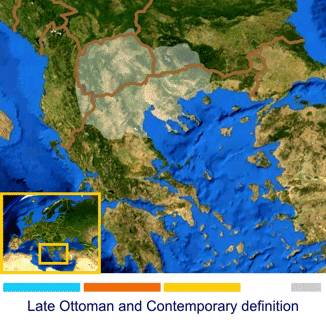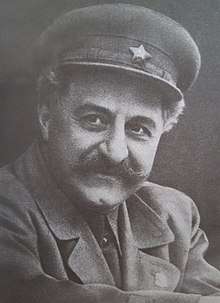Portal:Europe
| Main | Geography | Projects |
|
|
Europe is a continent located entirely in the Northern Hemisphere and mostly in the Eastern Hemisphere. It comprises the westernmost peninsulas of the continental landmass of Eurasia, and is bordered by the Arctic Ocean to the north, the Atlantic Ocean to the west, the Mediterranean Sea to the south, and Asia to the east. Europe is commonly considered to be separated from Asia by the watershed of the Ural Mountains, the Ural River, the Caspian Sea, the Greater Caucasus, the Black Sea, and the waterways of the Turkish Straits. Although much of this border is over land, Europe is generally accorded the status of a full continent because of its great physical size and the weight of history and tradition.
Europe covers about 10,180,000 km2 (3,930,000 sq mi), or 2% of the Earth's surface (6.8% of land area), making it the second smallest continent (using the seven-continent model). Politically, Europe is divided into about fifty sovereign states, of which Russia is the largest and most populous, spanning 39% of the continent and comprising 15% of its population. Europe had a total population of about 741 million (about 11% of the world population), as of 2018. The European climate is largely affected by warm Atlantic currents that temper winters and summers on much of the continent, even at latitudes along which the climate in Asia and North America is severe. Further from the sea, seasonal differences are more noticeable than close to the coast.
The history of Europe concerns itself with the discovery and collection, the study, organization and presentation and the interpretation of past events and affairs of the people of Europe since the beginning of written records. During the Neolithic era and the time of the Indo-European migrations, Europe saw human inflows from east and southeast and subsequent important cultural and material exchange. The period known as classical antiquity began with the emergence of the city-states of ancient Greece. Later, the Roman Empire came to dominate the entire Mediterranean basin. The fall of the Roman Empire in AD 476 traditionally marks the start of the Middle Ages. Beginning in the 14th century a Renaissance of knowledge challenged traditional doctrines in science and theology. Simultaneously, the Protestant Reformation set up Protestant churches primarily in Germany, Scandinavia and England. After 1800, the Industrial Revolution brought prosperity to Britain and Western Europe. The main European powers set up colonies in most of the Americas and Africa, and parts of Asia. In the 20th century, World War I and World War II resulted in massive numbers of deaths. The Cold War dominated European geo-politics from 1947 to 1989. After the fall of the Iron Curtain, the European countries grew together.
The culture of Europe is rooted in the art, architecture, film, different types of music, economic, literature, and philosophy that originated from the continent of Europe. European culture is largely rooted in what is often referred to as its "common cultural heritage".
The economy of Europe comprises more than 744 million people in 50 countries. The formation of the European Union (EU) and in 1999, the introduction of a unified currency, the Euro, brings participating European countries closer through the convenience of a shared currency and has led to a stronger European cash flow. The difference in wealth across Europe can be seen roughly in former Cold War divide, with some countries breaching the divide (Greece, Estonia, Portugal, Slovenia and the Czech Republic). Whilst most European states have a GDP per capita higher than the world's average and are very highly developed (Liechtenstein, Luxembourg, Monaco, Andorra, Norway, Sweden, Denmark, Netherlands, Switzerland, United Kingdom, Ireland, Germany), some European economies, despite their position over the world's average in the Human Development Index, are poorer.
Featured article -

The name Macedonia is used in a number of competing or overlapping meanings to describe geographical, political and historical areas, languages and peoples in a part of south-eastern Europe. It has been a major source of political controversy since the early 20th century. The situation is complicated because different ethnic groups use different terminology for the same entity, or the same terminology for different entities, with different political connotations.
Historically, the region has presented markedly shifting borders across the Balkan peninsula. Geographically, no single definition of its borders or the names of its subdivisions is accepted by all scholars and ethnic groups. Demographically, it is mainly inhabited by four ethnic groups, three of which self-identify as Macedonians: two, a Bulgarian and a Greek one at a regional level, while a third ethnic Macedonian one at a national level. Linguistically, the names and affiliations of languages and dialects spoken in the region are a source of controversy. Politically, the rights to the extent of the use of the name Macedonia and its derivatives has led to a diplomatic dispute between Greece and North Macedonia. After using the provisional reference of the "former Yugoslav Republic of Macedonia" (FYROM), Greece and the then-Republic of Macedonia reached an agreement that the latter would change its name to North Macedonia. It came into effect on 12 February 2019. (Full article...)
Featured location -

The Prince's Palace of Monaco (French: Palais princier de Monaco; Monégasque: Palaçi principescu) is the official residence of the Sovereign Prince of Monaco. Built in 1191 as a Genoese fortress, during its long and often dramatic history it has been bombarded and besieged by many foreign powers. Since the end of the 13th century, it has been the stronghold and home of the Grimaldi family who first captured it in 1297. The Grimaldi ruled the area first as feudal lords, and from the 17th century as sovereign princes, but their power was often derived from fragile agreements with their larger and stronger neighbours.
Thus while other European sovereigns were building luxurious, modern Renaissance and Baroque palaces, politics and common sense demanded that the palace of the Monegasque rulers be fortified. This unique requirement, at such a late stage in history, has made the palace at Monaco one of the most unusual in Europe. Indeed, when its fortifications were finally relaxed during the late 18th century, it was seized by the French and stripped of its treasures, and fell into decline, while the Grimaldi were exiled for over 20 years. (Full article...)
List of featured locations
|
|---|
Featured portrait
 |
In the News
- 29 March 2025 – 2025 Trondheim stabbing attack
- Four people are injured in a stabbing attack in Trondheim, Norway, with the perpetrator being arrested. (Euro Weekly News)
- 28 March 2025 – Russian invasion of Ukraine
- Dnipro strikes
- A Russian drone attack on Dnipro, Ukraine, kills four people and wounds 19 others. Multiple buildings in the city are reported to be ablaze, including a hotel, resort, a restaurant complex and numerous apartments. (Reuters)
- 28 March 2025 –
- Russian authorities say that yesterday's sinking of the Sindbad submarine in Hurghada, Egypt, killing six Russians, happened during boarding and not due to a collision as reported. (The National)
- 27 March 2025 –
- At least six people are killed and 39 others are rescued after a Sindbad submarine carrying Russian tourists sinks off the Red Sea coast of Hurghada, Egypt. (BBC News)
- British environmental activist group Just Stop Oil announces they will end all civil resistance, direct action, and vandalism-related protests immediately and disband by April 26 after the British government announced it will halt the granting of new oil and gas permits. (DW) (Government of the United Kingdom)
Updated: 11:05, 30 March 2025
Categories
Featured biography -
Sergo Konstantinovich Ordzhonikidze (born Grigol Konstantines dze Orjonikidze; 24 October [O.S. 12 October] 1886 – 18 February 1937) was an Old Bolshevik and a Soviet statesman.
Born and raised in Georgia, in the Russian Empire, Ordzhonikidze joined the Bolsheviks at an early age and quickly rose within the ranks to become an important figure within the group. Arrested and imprisoned several times by the Russian police, he was in Siberian exile when the February Revolution began in 1917. Returning from exile, Ordzhonikidze took part in the October Revolution that brought the Bolsheviks to power. During the subsequent Civil War he played an active role as the leading Bolshevik in the Caucasus, overseeing the invasions of Azerbaijan, Armenia, and Georgia. He backed their union into the Transcaucasian Socialist Federative Soviet Republic (TSFSR), which helped form the Soviet Union in 1922 and served as the First Secretary of the TSFSR until 1926. (Full article...)
Featured picture
 |
Related portals
Major Religions in Europe
Northern Europe
Western Europe
Central Europe
Eastern Europe, Balkans and Caucasus
Southern Europe
Featured panorama
 |
Topics
Associated Wikimedia
The following Wikimedia Foundation sister projects provide more on this subject:
-
Commons
Free media repository -
Wikibooks
Free textbooks and manuals -
Wikidata
Free knowledge base -
Wikinews
Free-content news -
Wikiquote
Collection of quotations -
Wikisource
Free-content library -
Wikispecies
Directory of species -
Wikiversity
Free learning tools -
Wikivoyage
Free travel guide -
Wiktionary
Dictionary and thesaurus

























